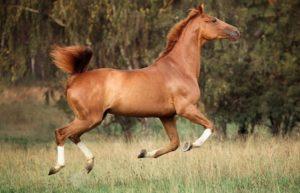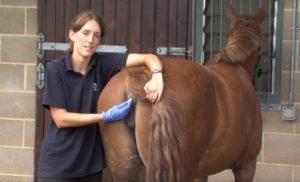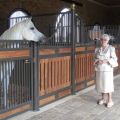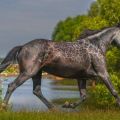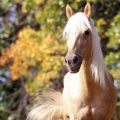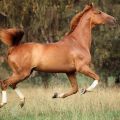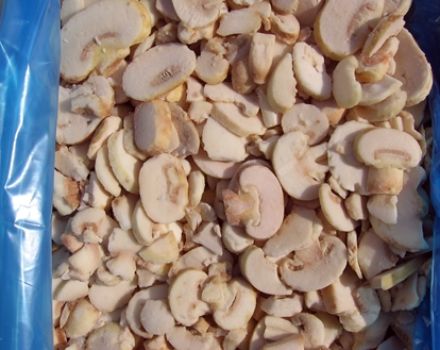How many teeth does a horse have and how to properly care for them, defects and treatment
Each owner is responsible for the health of the animals. It must be remembered that the horse's teeth and mouth are the most important organs. It is necessary to constantly monitor their condition and timely treat diseases or injuries. It is believed that thoroughbred horses have harder bone mass than normal horses. However, nutrition and care for any horses must be appropriate.
Horse teeth: structure and features
Horses of any breed have the same number of teeth: an adult stallion has 40, and a mare has 36. Experienced horse breeders determine the age of the animal by the state of the oral cavity. As a rule, horses have literally all of their teeth grinded by the age of 12. This process is influenced by several factors: nutritional quality, defects in the location of the upper and lower jaws.
Incisors
In total, there are 12 upper and lower incisors, they are permanent and milk. You can distinguish them by their shade and size: the permanent ones are larger, they stand out in yellowish color. Incisors are classified into three types:
- hooks are located in the center;
- the middle ones sprout on both sides of the hooks;
- edges.
The animal cuts greens with incisors, captures food and partially grinds food. It is with the incisors that horses are able to bite painfully.
Fangs
This species is considered a rudiment because these teeth are not involved in chewing food. Milk canines are common in all animals, but most adult mares (approximately 96%) do not have canines. Canine teeth erupt in animals most often at the age of 4-5 years. However, there are exceptions when eruption occurs earlier - at 2 years old, or later - at 7-8 years old.
The canines grow in a sharp shape, with a rough inner surface and a smooth outer surface. As a rule, the canines erupt close to the incisors, and as the horses grow older, they move away from the front teeth and unfold slightly. In this case, the inner surface loses its roughness and becomes smoother.
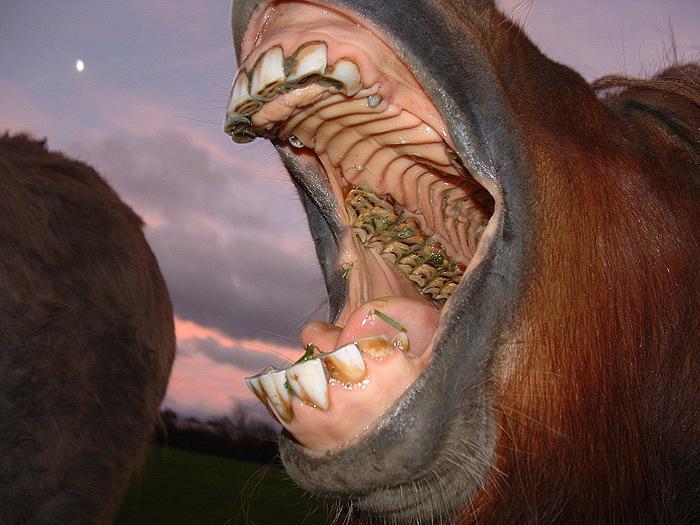
The upper canines in adult animals are erased to the gums, and the lower ones become dull and become slightly longer. The presence of a stone on the canine teeth indicates a significant age of the horse.
Permanent teeth
Each horse has 12 molars (molars), 6 on the upper and lower jaw. An empty gum section separates the molars from the incisors and canines. The molars are divided into milk teeth - premolars (change in an animal at the age of 2-3 years) and permanent.
Constants grow in horses at different ages. The first appears in 10 month old foals. Then they germinate at the age of 20 months.And the last indigenous ones appear in three-year-old horses. Since the eruption takes several years, this feature makes it possible to roughly determine the age of the animal. It is the molars that are involved in chewing large and rough food.
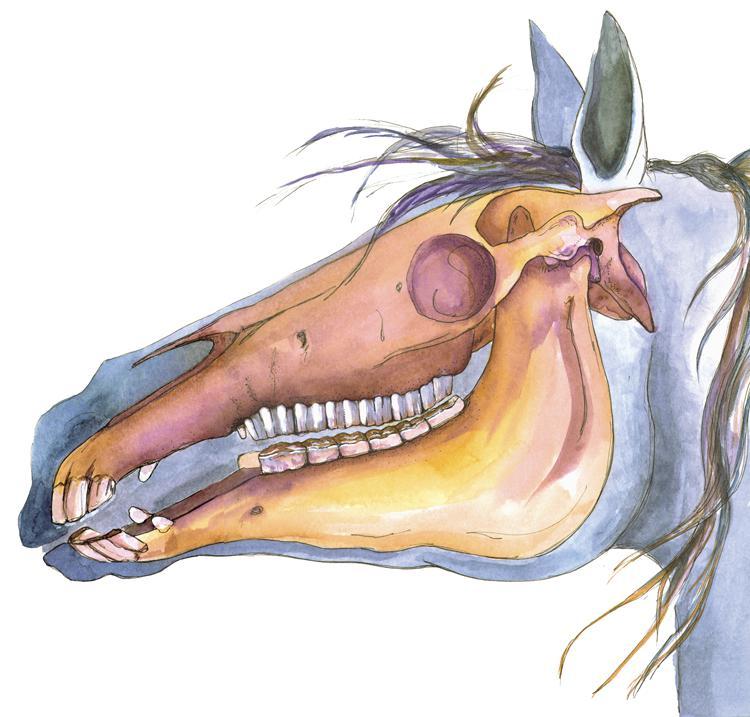
Vices and anomalies
The main defect is the appearance of an extra tooth (called "top" or "profitable"). This defect can occur in horses at different ages. "Volchok" is able to deliver discomfort to the animal and cause painful sensations. This is due to the fact that "tops" have a conical shape with a sharp top, grow haphazardly and lead to traumatic inflammation of the jaws, which contributes to changes in the behavior of the animal. The horse begins to chew slowly and carefully, the manner of eating changes, sometimes the animal loses its appetite. Usually "tops" fall out naturally after some time.
Important! If the "top" does not fall out for a long time, and the animal begins to feel pain and suffer, it is recommended to seek help from a veterinarian.
Much less common is the absence of incisors in the upper jaw. Naturally, such defects cannot be cured. Such horses are able to fully grow and develop, adapting to chew food like cows. An anomaly is the simultaneous germination of milk and root. At the same time, the erupting root changes its natural position relative to the gums. As a rule, the problems of delayed shift are solved by removing the milk.

Horse changing and teething
Stallions are usually toothless at birth. During the first 6-7 days of life, milk incisors and hooks appear. Later, the middle ones grow, the edges germinate at 8-9 months. As a rule, dairy products are replaced in animals under the age of five. At the age of 2-3 years, permanent incisors are replaced by falling out milk teeth.
How to properly care for your horse's teeth
Horses use their teeth to tear off the grass, grab and chew food, defend themselves and attack. Therefore, it is necessary to provide proper care for the vital organ. The horse breeder should examine the oral cavity of horses regularly so as not to miss signs of emerging diseases. The incisors should be firmly held, close evenly, forming one line. The enamel should be free of cracks.
A properly equipped feeding place is an important point in raising an animal. It is not recommended to hang the feeder high. Under natural conditions, the horse nibbles the grass and chews it with its head lowered. Under other conditions, tooth wear is faster. Sweet treats provoke rotting. Therefore, it is not recommended to give treats with sugar to horses. A healthy and healthy treat would be a regular carrot.
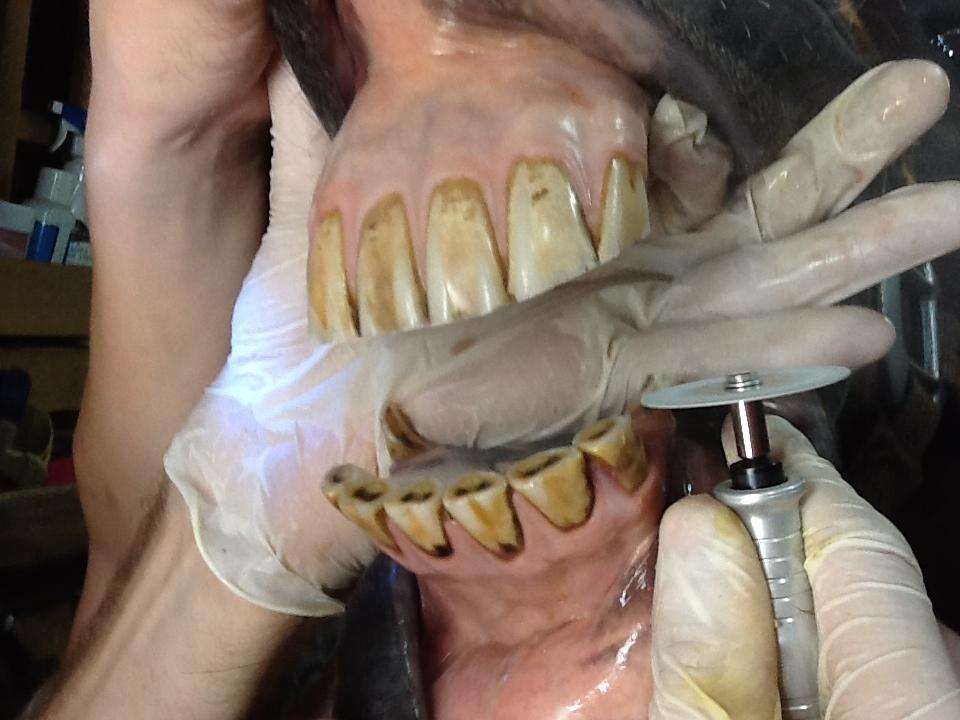
Advice! It is not advisable to hit the teeth with the bit as this can damage the incisors.
Diseases and their treatment
The most common is caries - a pathological process, damage to the enamel. Signs of the disease: small gray, brown spots appear on the tooth surface, gradually blackening, chewing movements are difficult, an unpleasant odor appears. The hard part of the tooth decays and other tissues are destroyed. Deep cavities can cause split teeth. The upper molars are more often affected, less often the lower ones. Treatment is prescribed depending on the degree of caries spread. In case of significant damage, the tooth is removed.
Violation of uniform abrasion of teeth provokes the appearance of sharp edges. A similar violation occurs in animals with a small amount of roughage. Since the inner buccal surface and tongue are constantly injured while chewing food, the horse's appetite decreases. You can get rid of the problem with a hand rasp, and you should also review the horse's diet.
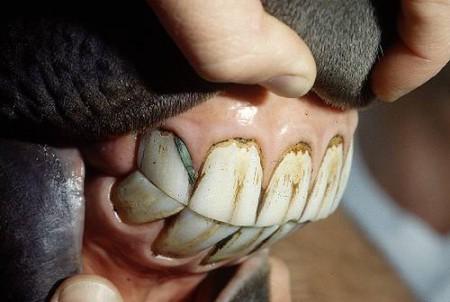
Cracks in the enamel appear as a result of mechanical damage (foreign elements come across in the feed - pebbles, chips, metal parts).
Injured teeth cause inflammation of the tongue and gums. Animals begin to consume less food or refuse to eat at all. The damage can be repaired with a rasp, the debris is removed under local anesthesia.
Horses' oral health should be monitored throughout the entire housing. Diseases and organ damage cause loss of appetite and physical fitness of the animal. In order for the animal to fully grow and develop, you need to regularly examine the teeth of the animals yourself, correctly formulate the diet and equip the place of detention.
